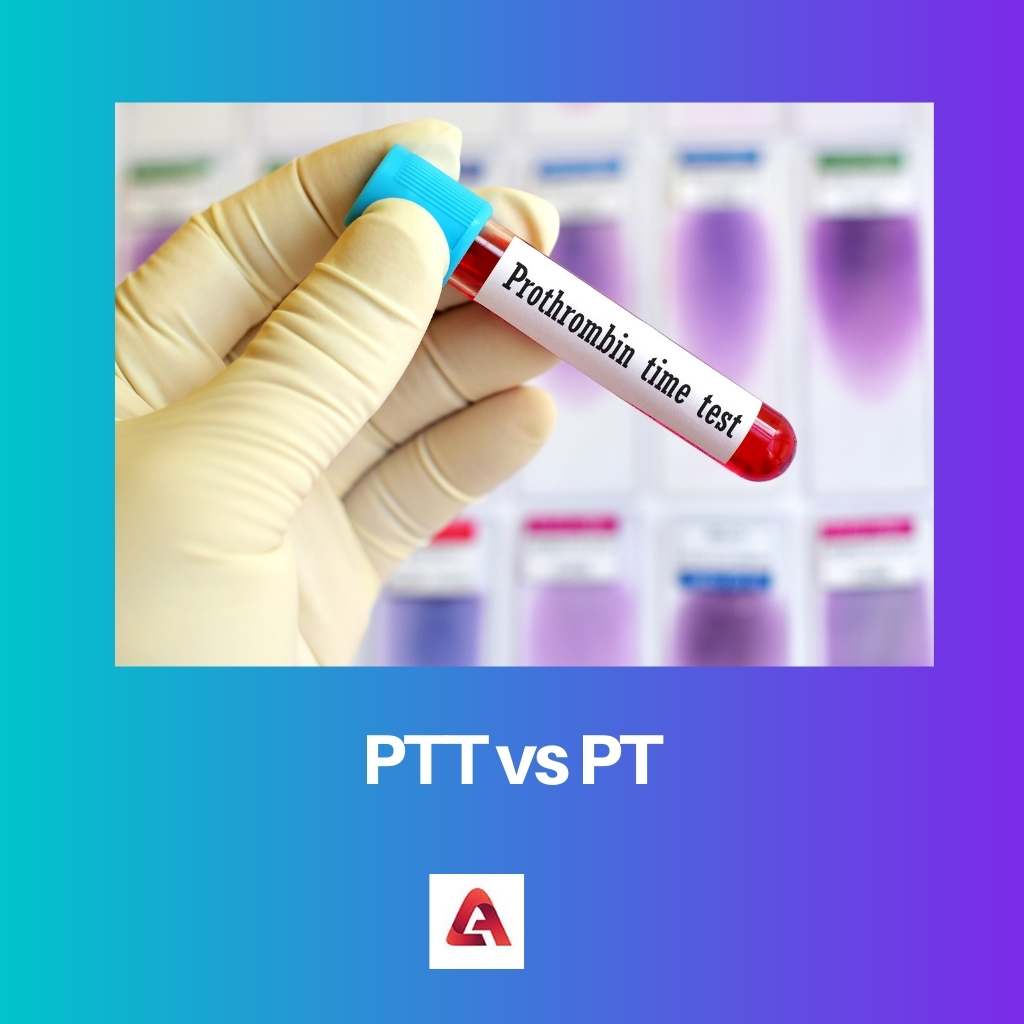PTT and PT are two different types of tests used to discover bleeding-related problems. Blood clotting is a process that starts after an injury that clots the blood and seals the wound. The blood coagulation process sometimes shows abnormalities, and to find out, these tests are done.
Key Takeaways
- PTT measures the time it takes for blood to clot through the intrinsic and common pathways, while PT measures the time for clotting through the extrinsic and common pathways.
- PTT is used to monitor heparin therapy, while PT is used to monitor warfarin therapy.
- PTT evaluates factors VIII, IX, XI, and XII, while PT evaluates factors VII, X, and V.
PTT vs PT
The difference between PTT and PT is that PTT measures the intrinsic coagulation pathway, while the PT test is conducted to measure the extrinsic coagulation pathway. The intrinsic and extrinsic are the two pathways that interact through which the clotting torrent occurs. Both the tests show the times it takes for the clotting of blood therefore, they are measured in seconds.

PTT stands for Partial Thromboplastin Time, a test conducted to check for bleeding problems like abnormal bleeding, etc. The intrinsic coagulation pathway is measured through the PTT test along with measuring the common coagulation pathway. The tissue factor is absent from this test, therefore, this test is called Partial.
PT stands for Prothrombin Time. It is a test the same as the PTT test to find out the blood problems, though, in this test, the extrinsic coagulation pathway is measured. The test is done to determine the cause of bruising or abnormal bleeding and to check the factors leading to a blood clot. Also, this test helps to check the low levels of vitamin K, along with the functions of the liver.
Comparison Table
| Parameters of Comparison | PTT | PT |
|---|---|---|
| Stands for | Partial Thromboplastin Time | Prothrombin Time |
| Measures | The intrinsic coagulation pathway is measured through this test. | The extrinsic coagulation pathway is measured through the Pt test. |
| Normal Value | The normal value of PTT is 25 to 39 seconds. | 11 to 16 seconds is the normal value of the PT test. |
| Clotting Factors | The clotting factors involved are I, II, V, VIII, IX, X, XI, and XII. | The clotting factors which are seen in the PT test are I, II, V, VII, and X. |
| Blood Thinning medicines monitoring | The PTT test monitors the levels of heparin. | The PT test monitors the levels of warfarin. |
What is PTT?
PTT stands for Partial Thromboplastin Time. It is a test used to measure the time which is taken for the blood to clot in a person’s body. The test is conducted to examine or determine the bleeding problems. It measures the intrinsic coagulation pathway along with the common coagulation pathway.
The test helps in finding the clotting disorder and the reason for excessive bleeding. It determines the time taken for blood coagulation and the cause of abnormal bleeding and also checks if the dosage given to the patient anti-clotting medicine is rightly used. It also looks at the timer for a blood clot before any surgery. The normal value of the PTT is 25 to 39 seconds.
Indeed, it checks for the factors which lead to blood clots that cause clotting problems. Factors I, II, V, VIII, IX, X, XI, and XII are the clotting factors that are noted in the PTT test.
The PTT test also measures and monitors the blood-thinning medicine level, i.e., the heparin level, in the body of the patient just in case the person is on anticoagulation therapy. The PTT test is called partial because the tissue factor is not present.
What is PT?
PT stands for Prothrombin Time. This test also measures the timing of the blood clotting in the body. The extrinsic coagulation pathway is measured through the PT test. In the PT test, the prothrombin ratio is determined. Also, the international normalized ratio is determined to know the effectiveness of the anticoagulant medicines in the patient.
The test is conducted to determine the causes of abnormal bleeding. It also checks if blood-thinning medicines are working or not. This test is important to find out the reason behind the problems in bleeding and clotting. This test helps diagnose if there are any clotting disorders in the patient.
The test also checks for the presence of the factors that lead to a blood clot, which are factors I, II, V, VII, and X. Also, the levels of vitamin K are checked through this test. And the functions of the liver are also checked through this test. The result of the test comes in seconds, the normal value being 11 to 16 seconds.
Moreover, the PT test also determines the levels of warfarin, which is an anticoagulant medicine. Also, the tissue factor is present in the PT test. The PT test measures the time that plasma takes to clot when the tissue factor is added. The test is performed by adding the plasma to some tissue factor source.
Main Differences Between PTT And PT
- PTT is Partial Thromboplastin Time, and PT is Prothrombin Time. The name itself suggests that the two are different tests.
- PTT measures the intrinsic coagulation pathway. On the other hand, the extrinsic coagulation pathway is measured through the PT test.
- The tissue factor is absent in the PTT test while it is taken into account in the PT test.
- 25 to 39 seconds is the normal value for the PTT test, while the normal value of PT is 11 to 16 seconds.
- The clotting factors I, II, V, VIII, IX, X, XI, and XII comes under the PTT test, while the clotting factors which come under the PT are I, II, V, VII, and X.




